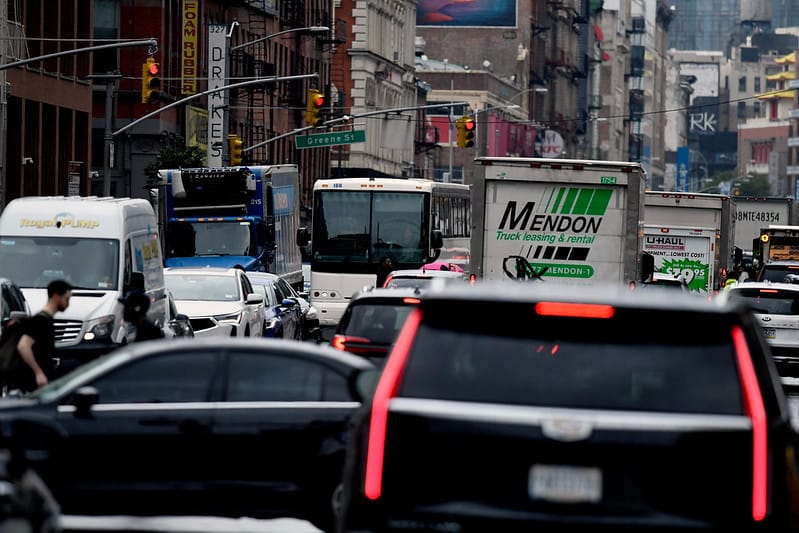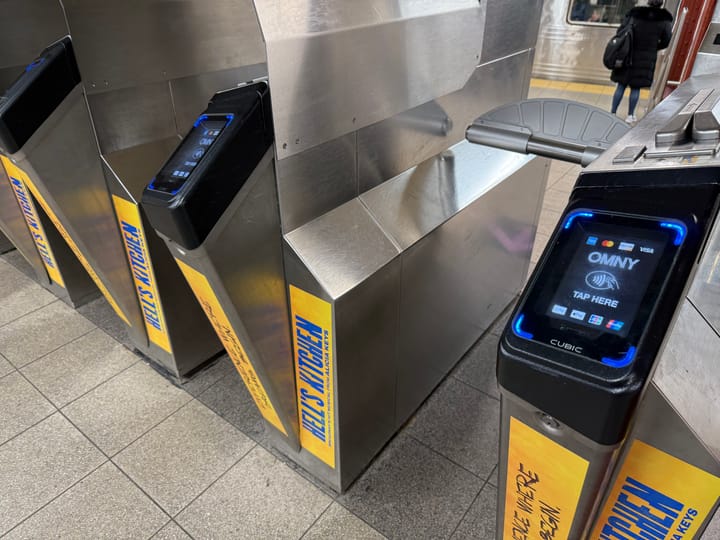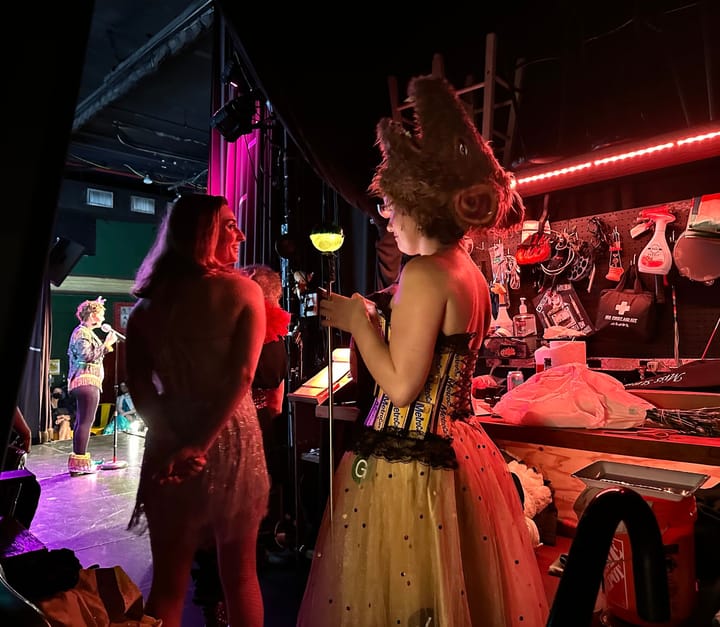Everyone else is speaking up about congestion pricing, shouldn’t you?
The public comment period is now open, don't let the haters from NJ have all the fun

By Tim Donnelly
If you’ve heard anything about congestion pricing lately, it’s probably someone complaining about it.
The teachers’ union filed a suit against it in a celebrity tag team with the entire borough of Staten Island; someone who sued Mariah Carey for calling herself the “Queen of Christmas” is also trying to stop it; the entire state of New Jersey — a land made entirely of EZ Pass lanes, beach badges and yelling — finally found a toll it doesn't like and filed a lawsuit against it.
Congestion pricing is a plan to make drivers pay a toll to enter Manhattan below 60th Street that could go into effect this spring. The toll would be $15 for peak hours, less for off-peak hours and more for both small and large trucks, with some discounts for low-income drivers, motorcycles and people who already paid a toll at the Lincoln, Holland, Queens-Midtown or Brooklyn Battery Tunnels. (Read the full toll price plan here.)
All that would in theory add up to $1 billion a year for the MTA and lead to $15 billion worth of projects to build, buy and fix stuff in the rapidly aging system.
The public comment period on the plan just opened, and those of us who actually live in New York City and not New Jersey, and are routinely stuck in buses behind a double parked car, or inhaling the fumes and honks of endless gridlock, or spend our time as pedestrians dodging would-be hit-and-runs, should probably speak up about it. If you've got a reason to be driving into Manhattan on a regular basis, you should pipe up too: if well-executed, the plan will even eliminate some of the people who choose to drive into the zone, and make more room for the people who actually have to.
“The haters seem to have tons of time and energy," Danny Pearlstein, policy and communications director of the Riders Alliance, told The Groove.
How to submit a congestion pricing comment
The public comment period opened on Dec. 27 and will close on March 11. You can make a comment online here or by email through cbdtp.feedback@mtabt.org. Comments are also accepted by phone at 646-252-7440.
If you’d rather scrawl out a ransom-style note to express your thoughts (or write like a regular letter), you can mail your comments to: CBD Tolling Program, 2 Broadway, 23rd Floor, New York, NY 10004 . If you’re real wild, send a fax to (212) 504-3148.
Why should you comment?
Implementing congestion pricing could be a massive shift, a big swing to reset some street priorities in one of America's only pedestrian-friendly cities. It's a way of going all-in on public transit for the common good: Tax the cars, unleash the buses, save the subway.
Other cities are watching closely to see how this first-in-the-nation effort goes down. At this point, it’s almost certainly going to happen — the MTA has already installed some cameras to read license plates — but how it happens is up for debate.
The toll is meant to be a circuit breaker in the brains of all the people who drive into the most transit-dense place in the country. Like the 5-cent fee on paper bags, part of it isn’t so much to raise money as it is to get people to consider whether a different option is possible. Do I need the bag? Is it worth $15 to not take a train to Midtown today?
“no reason to go into Manhattan” is a genuinely hilarious thing to say https://t.co/zbqbIAKLh0
— Ben Max (@TweetBenMax) January 9, 2024
But then, there is the part that is meant to raise money off all the cars who will still enter the zone: all the delivery trucks, for-hire-vehicles, and the regular passenger cars that carry only one person but block a crosswalk that 10 people are trying to use. That money will go to help fund subway, commuter rail and bus improvements, ostensibly making public transit a vastly more attractive option over time.
The MTA expects the tolls to raise $1 billion a year, and through bonding will turn that into $15 billion worth of projects for the 2020-2024 capital plan. It has big plans for that money: shiny stuff like new stations and clean-air buses, but also long overdue maintenance and upgrades on the creaky system. Dozens of stations are in line to get much needed accessibility improvements too, making it easier for even more people to use the trains.
But the MTA needs to hear from New Yorkers, because other folks are already speaking up.
"There are a lot of people who justifiably nervous about it," Pearlstein said. “There is a base of cynicism and surging cynicism."
Backers of the plan — a wide swath of environmentalists, walkers, bus riders and New Yorkers in the general “better things are possible” lobby — spent a lot of energy getting the measure approved by state lawmakers in 2019.
“This is not a popularity contest,” Pearlstein said. “The popularity contest already took place and it was decided popular enough to become law.”
Lisa Daglian, executive director of the Permanent Citizens Advisory Committee to the MTA, agreed: “The people who need to make noise are also those of us who support it.”
This is as good a time to remember a simple fact that must frame all this: most New Yorkers do not drive, or do so only very rarely: only 11 percent of commuters who work in the congestion pricing zone drive; 85 percent take public transit, according to MTA data. Only 1 percent of those drivers are low-income, according to the MTA. It's just not super fun to drive into Manhattan, and shouldn't be.
Yet still, turn on the coverage of the congestion pricing from TV news, national media and some international outlets and you will see interviews with only car drivers about how they feel about the plan. It’s like interviewing someone who keeps dumping dog shit on your stoop about the proposed tax on dumping dog shit on your stoop.
Even local outlets like Eater can’t help but let their New Jersey-living editors bring the car-owner perspective into their coverage.
Why, in a city where most people don’t drive, are they the only ones we’re hearing from the most?
What kinds of comments are people making?
The recurring refrain in situations like this – efforts that seek to stop something that aims to make the city safer but inevitably involves inconveniencing someone in a car, like the failed Prospect Park West bike lane suit of the 2010s — is that there was not a chance for public comment. “They shoved it down our throats!” critics decry, critics who obviously don’t subscribe to The New York Groove where we inform you of such ways to be involved.
Despite what you read in the lawsuits from the state of New Jersey and others, there have already been a few rounds of public comments on congestion pricing; you can read some here. So what have people been saying?
They range from the supportive:
“I'm a lifelong Manhattan/Queens resident. I am a driver, MTA rider, cyclist, pedestrian,” one person wrote. “Central Business District Tolling needs to happen as soon as possible. The amount of traffic increase in this city is just beyond what was imaginable just 15 years ago. … It's time to make changes. Our city is extremely behind other world level cities”
To the alternatives that don’t quite make sense:
“Why no(t) go after the illegal dollar vans that take millions away from the MTA.”
(In addition to dollar vans dying out in recent years, there would have to be a million dollar vans for this to be true).
To the legit concerns from a struggling industry:
“I strongly feel if you charge TLC cars a high congestion fee it will completely crash our business,” one limo driver wrote. “Business is already slow. I’ve been doing this for 12 years and I’m afraid if the congestion price is too high I will soon be out of a job.”
That last kind of comment is the most helpful at this stage, Daglian said: perspective that raise things the MTA might have missed when crafting the plan. One example she cited is a request for an exemption for school buses, which was not in the original proposal but could make it into the final plan.
Less helpful is the kind of comment that’s like “I should be exempt because I drive an electric vehicle,” unless said vehicle exists in a fourth dimension where it does not take up corporeal space, or “the entire state of New Jersey should be exempt because we’re miserable."
Do the public comments actually matter?
Yes, officials say. The agency tracks and reads every comment, and produces FAQ answers to common ones. Public comments have already helped shape the congestion pricing plan, including the hours the toll will be in effect, lower rates for motorcycles and some other exemptions.
“It’s not an ‘either or’ case,” Pearlstein said. “Things can be debated.”
The comments don’t stop court cases, but they go a long way to counteract the big loud lawsuits people are filing against congestion pricing, Daglian said.
“The other side of that is the thousands of comments that were received over public meetings,” she said. “That’s already been balanced”
I’m a sicko who likes long public meetings, can I make my comments in person?
You freak, go on with it: the four in-person meetings run from Feb. 29 to March 5, at MTA HQ, 2 Broadway in the William J. Ronan 20th floor board room, see the full schedule and register here.
Daglian advises attending one of the 10 a.m. meetings “so you can get home before midnight.” But the in-person meetings are often a great experiment in empathy to hear what passionate people are saying about the issue, and why they’re so concerned.
“Everybody wants their story told,” she said.
Congestion pricing is an idea that’s been around since as far back as the 1950s, Pearlstein said. The latest version started in 2007, long enough ago that Daglian used to look out her Hell’s Kitchen window at the line of traffic and joke about how there must be a game at the never-built westside stadium — a plan so old itself, it was a joke in the movie Hitch.
Lots has changed since the days of Hitch: cars got bigger, the planet got hotter and our buses became the slowest in the country (not to mention it’s near impossible to release a mid-tier star-studded romantic comedy in theaters anymore).
“All eyes in the nation are on New York,” Daglian said. “It’s important to get it right. New York knows it, the MTA knows it, and everyone knows it.”




Comments ()